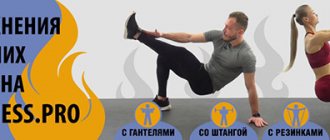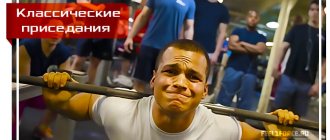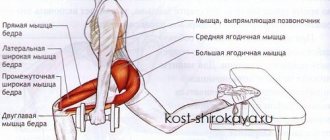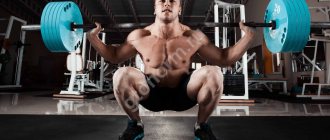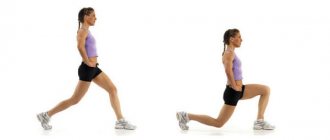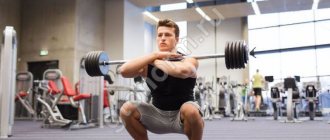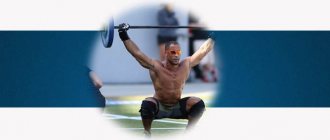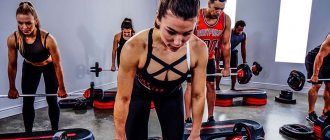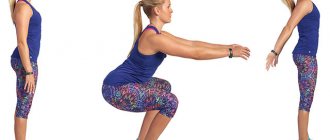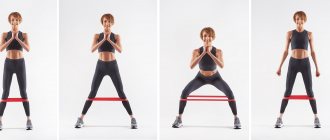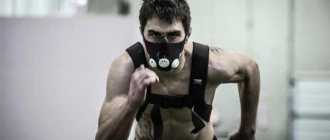The lunge exercise with a barbell on the shoulders pumps up the quadriceps, buttocks, and inner back of the thigh. In this case, the quadriceps is lengthened and formed. Formative exercise.
Lunges with a barbell on the shoulders “push out” the bottom of the quadriceps, which visually lengthens the thigh, especially when viewed from the side. Keep in mind: the shorter the quadriceps, the less proportional the legs will look. Back lunges are also very effective in targeting the buttocks and inner thigh muscles.
By regularly practicing back lunges, you will improve your stretching and soon you will be able to easily do the longitudinal splits, which is important for gymnasts, wrestlers, runners and football players.
Lunges with a barbell on the shoulders - an exercise for the leg muscles
Execution technique
Initial position
- The barbell is located on racks at the level of the athlete’s collarbones;
- The athlete takes it from the racks in one movement, bringing the body under the bar;
- The projectile is located on the trapezius muscles as conveniently as possible;
- If the goal is to work the quadriceps, you should hold your body more vertically and place the barbell higher;
- If there is more emphasis on the gluteals, the bar should be moved lower and a slight bend forward;
- Moving away from the racks resembles the same movement performed in a high-pants or low-pants squat variation;
- The athlete takes 2 steps back and places his feet wider than his shoulders.
Movement
- You need to take one step forward so that your hips determine the width of your feet;
- Next, we lower ourselves into a split squat, the knee of the front leg should be higher than the hip bone;
- The lower leg is perpendicular to the floor, or close to this angle;
- Full lowering is performed, to the maximum possible amplitude and lifting for a person
It's BAR LUNCHES, baby!
Attention
- Lowering the head and looking down leads to disruption of the trajectory of the projectile and possible injuries;
- You should refrain from rounding your back in both the thoracic and lumbar regions;
- The shoulder blades should be collected towards the spine;
- The exercise should not be performed so that the knee is “sharp” and the body rests on the thigh;
- You need to stand up in one movement, without lifting your buttocks;
- The work should be uniform, the length of steps on both sides should be the same;
- Even if an athlete is using light weights, resting the bar on the neck is a poor strategy and can lead to injury.
Common mistakes
In pursuit of a beautiful figure, pumped up buttocks and elastic legs, athletes often perform exercises incorrectly, which as a result does not give the desired effect and is fraught with injuries. We bring to your attention typical mistakes when performing lunges with a barbell.
- Correct placement of the knees. The knee of the working leg, which was used to take the step, does not protrude beyond the foot and, together with the thigh, should form a right angle. The knee of the supporting leg does not touch the floor, it should hover above it.
- Correct foot stance. You don't need to place your feet too close or too wide. The familiar pose, with feet slightly wider than shoulder width apart, is the most optimal and suitable for lunges with a barbell.
- Smooth back. Bent lunges are difficult to do. Weights aggravate slouching. Additional weighting in the form of a barbell increases the risk of injury when performing the exercise.
- Loose neck. The barbell is placed at the top of the shoulder blades, not on the neck. The cervical vertebrae are not capable of supporting such a large weight. Violation of this rule threatens, at a minimum, with a strained neck muscle.
- Proper warming up of muscles. When working with heavy weights, you must do a warm-up and tone your muscles and ligaments in every possible way.
- The heel is the point of emphasis for lifting the body. Lifting is carried out by pushing the heel of the working leg off the floor. There is no need to bend or pull yourself into a vertical position in any way, straining the muscles of your buttocks - you have weight on your shoulders and such maneuvers are dangerous to your health.
- Ability to keep balance. It is necessary to learn how to maintain balance without additional loads before performing lunges with a barbell. If you stagger with additional weight on your shoulders, the risk of injury increases, and there is a ban on exercising with this apparatus.
Recommendations
- Touching the floor with your standing foot from behind is allowed only if it is soft; you should not hit the kneecap on the floor;
- The movement should be quite deep, especially if the goal is to pump up the gluteal muscles;
- The core and abs should be kept tense in order to maintain the full anatomical relief of the spine;
- It is necessary to check the position of the shin of the leg that is in front. If it does not correspond in any way with the perpendicular, the position should be changed, because this position is dangerous for the ACL
Execution options
- Walking lunges . This option consists in the fact that the exercise is not performed alternately with the right and left legs, but as if constantly. The athlete steps forward, constantly moving the leg forward and alternating legs. This movement is mistakenly considered an exercise for the buttocks; in fact, the load is evenly distributed between the gluteal muscle and quadriceps. But what this exercise really does is burn a lot of energy. The movement is very energy intensive, and therefore it is used for all cases where it is necessary to expend a large number of calories. In addition, a walking lunge can be a good option for developing running speed and step depth;
- Front lunges with barbell . They differ in that the barbell is taken by the athlete on the clavicle bones, the hands are positioned as with a barbell in a front squat, that is, either crosswise or with raised elbows and wrists. The peculiarity of the frontal hold of the projectile is that it does not give the athlete;
- Sitting in different strides . In this version of the lunge, you do not need to return to the starting position every time, placing one foot next to the other. A split squat is performed, that is, a lunge forward, and all repetitions are in this position, and only then the leg is placed. This option is more convenient for those people who perform workouts with heavier weights.
- Long stride movement . This option is used by those who want to make their buttocks a priority. Long stride lunges are not powerful and require a moderate amount of effort to do them. Typically, the long stride movement is performed in a split manner so that the athlete does not overload the muscles.
Lunges with a barbell: execution technique
Tips: Lunges with a barbell on your shoulders
1. Be sure to lower yourself in the squat until your front thigh is parallel to the floor (90° knee angle). It is this position that ensures that not only the quadriceps, but also the muscles of the back of the thigh, including the buttocks, will work at full strength. The lower you squat, the greater the load on the hamstrings and buttocks.
2. Do not relax your psoas and abs until the very end of the set. Otherwise, you will not be able to stop yourself from rounding your back and leaning your torso forward during the lunge, which is extremely dangerous and can lead to injury.
3. The step back (lunge) must be wide enough, otherwise at the bottom of the exercise the lower leg will be tilted forward, which is extremely undesirable, since this transfers part of the load from the quadriceps to the knee joint, which reduces the effectiveness of the exercise and increases the risk of injury.
httpv://www.youtube.com/watch?v=embed/rXpCTnt9oyc
4. The main target of back lunges is the muscles of the front of the thigh, quadriceps. They are the ones who play the first violin here. The hamstrings and glutes in this exercise only assist the quadriceps (although, it is worth noting, they are very effective). Therefore, if your hip joint is not flexible enough, go down only as far as you can keep your torso upright and your lower back arched. After all, it is much more important to protect the spine from injury than to force the muscles of the back of the thigh and gluteus maximus to work at full strength. Moreover, you can do this using targeted exercises such as barbell curls, Romanian get-ups, deadlifts, and so on.
5. Taking a deep breath and holding your breath for the duration of the lunge increases intra-abdominal pressure, which helps keep the muscles surrounding the spine in constant tension. Which, in turn, ensures that you do not tilt your torso or round your back. In addition, holding your breath makes you stronger and allows you to generate more powerful force, which undoubtedly stimulates muscle growth.
Analysis of the exercise
What muscles work
Main : quadriceps and gluteus maximus
Auxiliary : the entire array of thigh muscles plus the gastrocnemius, soleus, and core as a stabilizer. The hamstrings work in this exercise the more, the wider the step is. The movement also loads the spinal extensors, especially if they are actively involved when bending over, and the exercise is performed with a low barbell
Advantages
- This is a unilateral exercise that allows you to get rid of asymmetry in the body. It works well not only in the absence of leg stall in deadlifts and weak squats, but also for aesthetics. People by nature are not very symmetrical; sometimes it is visually clear that a person has hips and buttocks of different sizes, and then unilateral exercises come to the rescue. In addition, they allow you to become stronger by objectively increasing the load on the muscles. They are also more useful during the rehabilitation period and for people with spinal injuries due to the fact that they can be used with lighter weight;
- Improves balance and allows you to move more coordinated. Because of this, they contribute to the activation of motor reflexes necessary to perform various complex coordination movements. Lunges forward and backward are included as special preparatory exercises in the training plans of runners, crossfitters, and representatives of team sports;
- A variety of variations with working weight are possible. More than with dumbbells - if this is necessary to strengthen the legs, and less if we are talking about a front lunge. Sometimes the exercise is performed with a shock absorber around the hips
Flaws
- The exercise is not suitable for a beginner until he has mastered squats and lunges with dumbbells. Typically, such beginners do not have enough physical capabilities to do lunges with a barbell evenly;
- The movement is not suitable for lower limb injuries;
- Girls with a long femur are not always comfortable performing the exercise in such a way that the spread is complete; many simply have to move the knee to the side and use a reduced range of motion;
- They require more time due to the very nature of the exercise. First, the muscles of one leg are worked, then the other;
- The movement is technically complex, and the technique must be observed, since all the most complex injuries from the point of view of sports medicine can be obtained in this movement;
- To perform lunges with a barbell you need at least racks and a barbell
Preparation for execution
Before performing the exercise, you need to make sure that the stands for performing the movement are stable, the bar is installed correctly and that there will be no mistakes or falls due to incorrectly installed weight.
It is necessary to carefully check the height of the racks so that it is convenient to remove the bar and move away from the racks. The warm-up should begin without weight, then gradually add weight on the barbell.
Proper execution
- The bar is located on the midline of the trapezius muscle or just below;
- The movement when moving away from the racks is smooth; you should not cling to the racks with the bar or bend your knees in any way;
- The exercise is performed exclusively using the legs; “working” with the back is prohibited;
- Before you start moving, you should take a deep breath and, through it, stabilize the spine and minimize the tilt of the back;
- The movement should begin with bending the knee joints, and not with moving the pelvis back;
- Work with the hips is allowed, hip abduction can be at the angle allowed by the hip joint, there is no need to artificially parallelize the feet;
- The optimal depth of the squat is determined by the anthropometry of the athlete; ideally, it is necessary to descend into a deep squat so that the thigh is parallel to the floor or slightly lower;
- In the starting position, the feet are at the width that is convenient for a squat; it makes no sense to artificially place them
LUNCHES. The most EFFECTIVE Technique for FIRMER BUTTOCKS! Borisova Anna
Errors
- Exit on the toes or misalignment on the edge of the foot;
- Toe goes beyond the line of the foot;
- Back bending;
- The bar is skewed on the back;
- Hitting the kneecap on the floor;
- Undersquat, that is, insufficient squat depth
Efficiency Tips
- Try to do the eccentric phase while holding your breath, this will give more stability to your back;
- You can move the toe of the working leg until the position of the body is stable;
- The wider the step, the more the gluteal muscles are involved in the work.
What muscles work?
An excellent basic exercise that works the quadriceps, gluteus medius and maximus, hamstrings, extensors of the fascia lata, oblique abdominal muscles and, of course, stabilizer muscles - the twins, gluteus minimus, piriformis, and internal oblique abdominal muscles. In static conditions, the rectus abdominis muscle also works quite well; in dynamics, the spinal extensors “plow” at full speed, especially in the lumbar portion. In a word, it’s easier to list which muscles do not work (although are there any?) in this exercise.
© Makatserchyk — stock.adobe.com
And, in fact, what does this give us? Increased endurance of leg muscles due to the powerful development of the mitochondrial apparatus, improved muscle coordination due to increased strength of the so-called. “core muscles” (buttocks, abs, lower back), it is these groups that are responsible for the effective interaction between the “upper” and “lower” floors of the body. In addition, they are also responsible for the correct position of the spinal column and, with proper development, ensure the correct functioning of the musculoskeletal system and internal organs in the projection of the lumbosacral region.
Additionally, developing the muscles in this area will improve your performance in sports such as wrestling, weightlifting, track and field, and CrossFit. And, the last from the point of view of practical benefits, but the first from the point of view of most gym goers, the effect is well-developed, voluminous and “dried” (with proper nutrition) leg muscles, toned buttocks, well-developed abs.
There are quite a large number of varieties of lunges: to the sides, “classic”, back, in “Smith”. What is the fundamental difference? Let's figure it out in order.
Inclusion in the program
The exercise requires significant coordination of movements, and cannot be performed by a person who has problems in this area. It is usually planned at the very beginning so that the legs are not tired.
In plans designed to increase strength, it is used as a second auxiliary, auxiliary exercise. The set-repetition range can vary from 8-10 repetitions, and the number of approaches can be no more than 5.
At the very initial stage, coordination of movements is still impaired, and it is necessary to practice the movement without weight. This stage can drag on for a long time, and you should not force it.
Contraindications
- Lunges with a barbell on the back are contraindicated and are not recommended for those athletes who cannot tolerate axial loads. We are talking about patients with intervertebral hernias and various protrusions;
- A weak muscle corset must be strengthened before the athlete performs the exercise with heavy weights;
- If an athlete has a problem back, it is better to perform lunges with dumbbells. The situation of a problematic back also includes hyperlordosis of the lumbar region;
- Otherwise, contraindications to lunges with a barbell are standard, these are injuries from which the athlete has not yet recovered, chronic diseases and viral diseases
The benefits and harms of exercise
Barbell lunges provide many benefits to athletes. We offer you a list of the benefits of this exercise:
- improved coordination and balance;
- development of leg strength;
- pumping the muscles of the legs and buttocks;
- working out all groups of leg muscles, even hard-to-reach ones;
- increasing performance in other strength exercises for the legs;
- development of flexibility and mobility of hip joints;
- working out all the gluteal muscles;
- increase in the volume of the main muscles of the thighs and calves;
- strengthening the muscles of the back and abs;
- pumping the muscles of the arms and neck;
- training endurance, concentration and balance;
- relaxation of spinal tightness;
- increased blood circulation in the pelvic area;
- improving the functioning of internal organs.
Barbell lunges for men and women can cause serious harm to health if performed incorrectly. To avoid this, you need to work with optimal weight, increase it gradually and adhere to the technique of performing the exercise.
Weighted lunges put a lot of stress on the leg muscles, tendons, and knee joints. If you have injuries or problems with them, it is recommended to refrain from such exercises or replace them with ones that are more gentle on the joints.
The risk group for whom lunges are contraindicated also includes the following indicators:
- phlebeurysm;
- hypertension;
- chronic back diseases;
- hernias;
- recent operations;
- heart disease;
- pregnancy;
- various neuralgia.
Interesting fact
Lunges have gained popularity not only in strength sports, but also in bodybuilding. Sean Ray, a veteran of the Olympia scene, says that this is an excellent exercise for defining the leg muscles, and it is difficult to replace it with anything else. Domestic bodybuilders also speak positively about lunges.
From the world of women's bodybuilding, lunges are loved by Dana Lynn Bailey and Erin Stern. The movement is included on an ongoing basis in weightlifting and powerlifting programs
What to replace
- You can change the equipment to an accessible one - do lunges with dumbbells, a barbell, kettlebells, sandbags, or by fixing one leg in the TRX simulator;
- You can do this exercise in a Smith machine. Some manage to do something like lunges in a hack machine, but this option is not recommended due to the high risk of injury;
- If the athlete only has rubber shock absorbers at hand, there may be two options - either wrap them around the hips and then the movement will be aimed more at developing the gluteal muscles, or throw them over the shoulders and place the foot of the working leg on the shock absorbers;
- The one-legged squat option without weight can replace lunges if there is no equipment at hand;
- Smith lunges are recommended for those who find it difficult to maintain balance in the classic version of this exercise; they can be used in programs for bodybuilders and fitness, but are strictly not recommended for those whose main skill is to develop coordination. Smith lunges are not suitable if the athlete's main goal is to increase stability while working on the track or in weightlifting movements.
Overall, this is an excellent exercise that combines strength and coordination elements, works the legs and strengthens the ligaments. Lunges can be done 1-2 times a week on an ongoing basis, not forgetting about the periodization of working weights.
Lunges with a barbell for the gluteal muscles. The best exercises for the buttocks from the fitness trainers of the Md Fit club
Igor January 14, 2020
